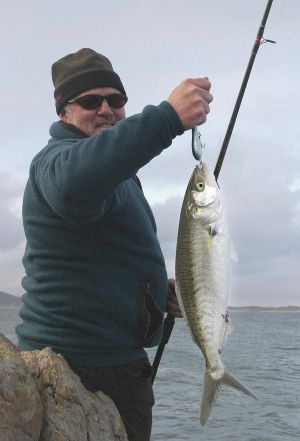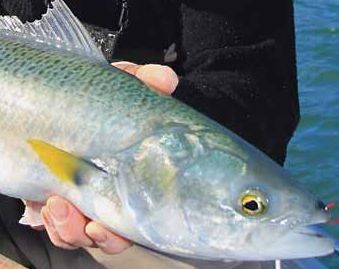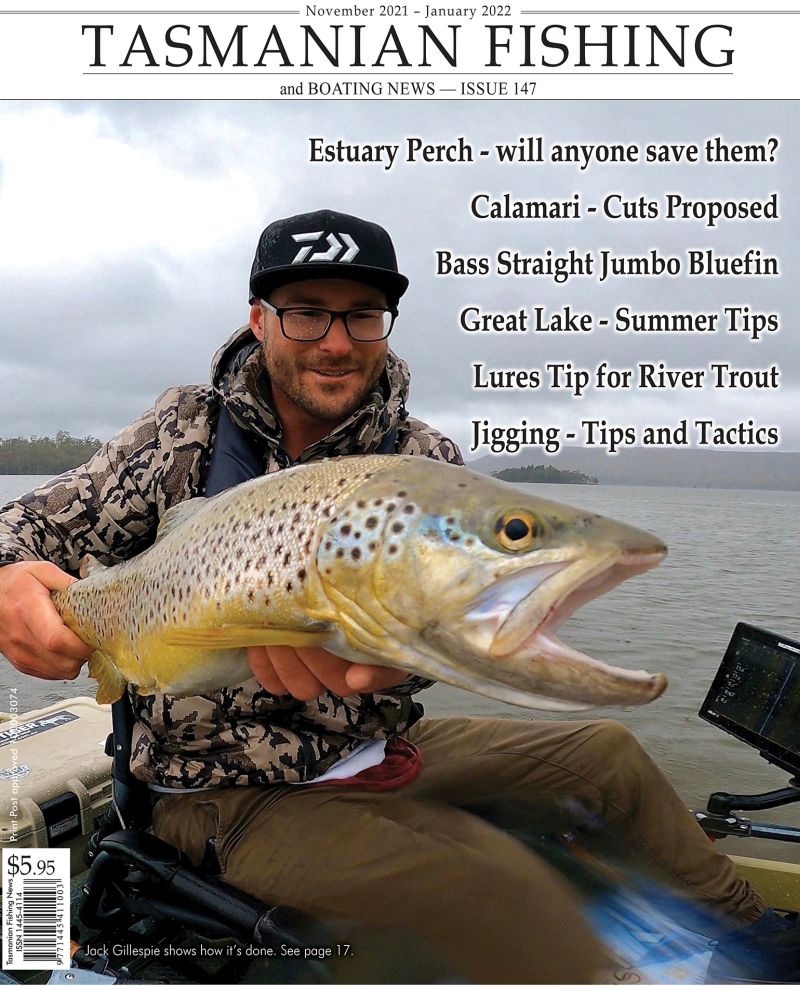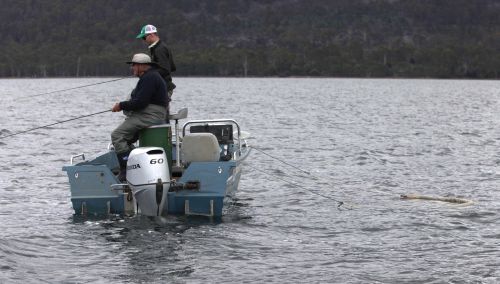From the Archives ...
Fishing on the Wild Side
Fishing on the Wild Side
Mike Fry doesn’t only live on the Wild Side of Tasmania, but also goes fishing in probably the wildest boat ever to troll for trout—certainly in Tasmania.
When your mate says ‘What are you doing tomorrow, want to come up the Gordon for the night?’ it would be pretty hard to say anything else except “you bet” and start checking out your tackle box and packing your overnight bag. But if your mate was Troy Grining and he wanted to give his new 52ft, high speed cruiser a run across Macquarie Harbour, test the new onboard dory with a chance of landing a nice Gordon River Brown you would have to feel privileged. I didn’t say anything about getting on my hands and knees and kissing his feet…just having a lend of ya’ but I did feel very appreciative.
 Presented from Issue 110, June 2014
Presented from Issue 110, June 2014
Winter is a time when we tend to slow down, the days are shorter and the weather is predictably cold, wet and windy. Some of us stop fishing all together and are happy to wait out the winter while others eagerly await the winter run of juvenile Australian Salmon. These fish often sneak into the quiet estuaries that are now free of summer anglers, skiers and jet skiers. They come into these estuaries to feed on the scattered bait schools, worms and prawns that live over the sea grass and shallow rocky shorelines.
- Written by Stephen Smith - Rubicon Web and Technology Training
- Category: Australian Salmon
- Hits: 6920
 Presented from Issue 106, October 2013
Presented from Issue 106, October 2013
Whilst I have spent a lot of time fishing from the shore in recent times I have really enjoyed fishing from a kayak, so I will cover that as well.
Locations One of the absolute prime spots for Australian salmon in Tasmania is the northern part of the West Coast. You will see Marrawah on the map and close by are two of my favourite places, Nettley Bay and Sinking Rock, off the north eastern side of Green Point. These are consistently prime places as is both East and West Inlet, although I would favour West Inlet over the two.
- Written by Stephen Smith - Rubicon Web and Technology Training
- Category: Australian Salmon
- Hits: 10791
Read more: Australian salmon - Tasmania’s most popular sportfish - Rodney Howard
 Presented from Issue 100
Presented from Issue 100
In Tasmania, larger Australian Salmon over two pounds are often called Black Back Salmon while the smaller models are known as Cocky Salmon. These fish are a valuable and much loved light tackle sports fish that are enjoyed by both land based and boating anglers all around Tasmania. They are a common catch in our estuaries, along our beaches and rocky headlands, and around the many small islands. They are a schooling fish that are constantly on the move along our coastlines, feeding predominantly on krill and small baitfish. They can be found in an estuary or along a particular part of the coast one week and then gone the next, as they move with the changing tides that influence the food they eat. Their presence rarely goes unnoticed when they turn up, as reports of anglers success quickly filters through the local angling community who gather in large numbers to make the most of these fantastic fish.
- Written by Stephen Smith - Rubicon Web and Technology Training
- Category: Australian Salmon
- Hits: 9920
Presented from Issue 97
Rebounding stocks of Eastern Australian Salmon along the eastern coast and a revealing study into the salmon’s life history have prompted Fisheries NSW to refine the balance between conservation, sport and industry.
Research findings from an FRDC-funded project have resulted in Fisheries NSW relaxing a 10- year restriction on the commercial take of Eastern Australian Salmon along the NSW coast, north of Barrenjoey Head.
The revised management code for northern NSW replaced a daily bycatch limit of 100 kilograms and permits allowing fishers to retain Eastern Australian Salmon as bait, with a 224-tonne-a-year commercial fishery as of 1 December 2011.
- Written by Stephen Smith - Rubicon Web and Technology Training
- Category: Australian Salmon
- Hits: 7312
Salmon for Christmas anyone?
by Sarah Graham IFS
Saltas Atlantic salmon - being set free at Craigbourne Dam
Saltas recently donated 450 Atlantic salmon with an average weight of 3 kg to the Inland Fisheries Service. These trophy salmon were stocked into Lake Meadowbank (150) and Craigbourne Dam (300) on Monday 13 December, just in time for Christmas.
- Category: Australian Salmon
- Hits: 6070
Australian Salmon
Shane Flude
There would be few Tasmanian anglers that have not caught at least a few Australian salmon. They are commonly called blackback in Tasmania with the smaller fish being known as cocky salmon. Many anglers target them specifically whilst others are simply caught as a bycatch. There can be no doubting their fighting abilities and they will test light gear to the limit. There have been numerous articles written over the years on this most popular sportsfish describing the correct techniques,tackle and fishing locations. There has not been much written about the life cycle of the fish itself and their general ecology in Australian waters. Shane Flude has done some research on our humble salmon and discovered some interesting facts.
- Category: Australian Salmon
- Hits: 20127
North-west Coast Australian Salmon
Jamie Harris
The small town of Marrawah on the rugged west coast is home of the famous land based fishing platform called Sinking Rock. Make sure you pronounce it Mar-u-war if you want to fit in. Many of you would have heard of this spot or are probably already regular visitors to this great place, but for those of you who are not it is not as far out of the way as you think and it's easily accessible.
- Category: Australian Salmon
- Hits: 12935
Australian Salmon
Andrew Large looks at one of Tasmania's favourite sport fish - Australian salmon.Tasmania is fortunate to have two types of salmon roaming our coastline. The two closely-related species are the Eastern Australian salmon and the Western Australian salmon.
- Category: Australian Salmon
- Hits: 30553
Australian salmon - exploding the myths
The Australian salmon needs little introduction to beach fisherman along the southern coastline of out continent. Sought by recreational fisherman because of its fighting qualities, salmon are also a significant commercial fish extending along the southern coastline from Sydney in the east to Perth in the west.
- Category: Australian Salmon
- Hits: 10005
Current TFBN
Click above for current issue content. The current issue of TFBN is extensive and topical. In Tackle Stores, Newsagents and by subscription.
Delivered to your door for $48 for 2 years (8 issues). To subscribe, send Mike $48 via www.paypal.com.au . (Basic instructions are here) The email is at Contact Us. Your address will be included from PayPal.
Or phone Mike with your c/c handy on 0418129949
Please ensure your details are correct, for Mike to organise delivery.
TFBN Newsletter Sign up Form
Why not submit an article ?
When you have finished for the day, why not have a brag about the ones that didn't get away! Send Mike an article on your fishing (Click here for contact details), and we'll get it published here. Have fun fishing - tasfish.com
Category Descriptions
Here is a list of all of the Article Categories. The number in Brackets, eg (13) is the number of articles. Click on Derwent River and all articles relating to the Derwent will be displayed in the central area.
Articles by Category
-
Rivers (3)
-
Saltwater and Estuary Fishing (149)
-
Kayak Fishing (34)
-
Lakes (1)
-
Great Lake (62)
-
Lake Leake (52)
-
Woods Lake (16)
-
Lake Augusta (11)
-
Huntsman Lake (13)
-
Lake Pedder and Gordon (10)
-
Lake Dulverton (5)
-
Lake Crescent (6)
-
Tooms Lake (10)
-
Lake Mackintosh (2)
-
Lake Barrington (5)
-
Little Lake (8)
-
Meadowbank Lake (5)
-
Lake King William (7)
-
Lake St Clair (2)
-
Western Lakes (12)
-
Arthurs Lake (35)
-
Lake Echo (7)
-
Four Springs (54)
-
Lake Sorell (7)
-
Lake Burbury (6)
-
Other Lakes (57)
-
Brushy Lagoon (18)
-
Little Pine Lagoon (5)
-
Penstock Lagoon (16)
-
Brumbys Creek (7)
-
-
Events (48)
-
Estuary Fishing (0)
-
Coastal Catches (46)
-
Super Trawler (46)
-
IFS, DPIPWE, MAST and Peak Bodies (435)
-
Commercial Interests (98)
-
Other (24)
-
TFBN Back Issues (8)
-
Fly Fishing (67)
-
Trout Fishing (250)
-
Meteorology and Weather (8)
-
Jan’s Flies (50)
-
Tuna Fishing and other Game Fishing (86)
-
Cooking Fish (19)
-
Fishing Information (1)
-
Fishing Books (8)
-
Videos (5)
-
Tackle, Boats and other Equipment (146)
-
World Fly Fishing Championship 2019 (2)
Popular Tags
windyty.com
Visit https://www.windyty.com/
Rubicon Web and Technology Training
Hello everyone, I thought it would be a good time to introduce myself.
My name is Stephen Smith and I have been managing the website tasfish.com since May 2009.
It has been an epic journey of learning and discovery and I am indebted to Mike Stevens for his help, support and patience.
I am developing a new venture Rubicon Web and Technology Training ( www.rwtt.com.au ). The focus is two part, to develop websites for individuals and small business and to train people to effectively use technology in their everyday lives.
Please contact me via www.rwtt.com.au/contact-me/ for further information - Stephen Smith.
From the Archives ... (last chance)
Sea runners - Early Season Excitement - Christopher Bassano
Presented from Issue 100
Considering the world class quality of our sea trout fishery, these fish are not sought after by enough anglers. Sea runners live in the salt water and run up our estuaries and rivers from the start of August to the middle of November. At this time of the year, they are here to eat the many species of fish that are either running up the rivers to spawn or are living in and around the estuary systems. Trout, both sea run and resident (Slob Trout) feed heavily on these small fish which darken in colouration as they move further into fresh water reaches.
The majority of these predatory fish are brown trout with rainbows making up a very small percentage of the catch. They can be found all around the state but it would be fair to say that the east coast is the least prolific of all the areas. They still run up such rivers as the Georges (and many others) but their numbers along with the quality of the fishing elsewhere make it difficult to recommend the area above the larger northern, southern and western rivers.
Read more ...


